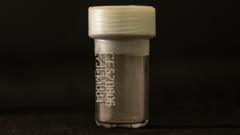The first Moon rock samples to arrive in the UK in almost 50 years have made their long-awaited journey from China, marking a significant milestone in lunar research and international scientific collaboration. Professor Mahesh Anand, the sole scientist in the UK entrusted with this precious lunar material, describes the tiny grains of dust as "more precious than gold dust," underscoring their rarity.
Collected during China's Chang'e 5 mission in 2020 from a volcanic region known as Mons Rümker, these samples are set to unlock new insights into the Moon's formation and the early history of Earth. The robotic arm used in the mission successfully retrieved 2kg of material, a notable achievement that established China as a key player in the modern space race. For the first time, China has selected seven international researchers to analyze these samples, fostering a spirit of global cooperation among top scientists.
Anand, who personally collected the samples during an elegant ceremony in Beijing, flew back to the UK with this extraordinary cargo securely stored in his hand luggage. At his laboratory in Milton Keynes, strict protocols are observed to avoid any contamination, as dirt from Earth could compromise the precious lunar dust's analysis.
As the samples were unveiled in a secure area of the lab, Anand explained their significance in understanding the colossal impact theory that theorizes the Moon's origins from the debris resulting from a colossal collision between Earth and a Mars-sized planet approximately 4.5 billion years ago. The samples, though appearing modest in their see-through vials, carry vast potential for revolutionary scientific discoveries.
Technician Kay Knight, who has a wealth of experience working with extraterrestrial materials, expressed her excitement about being the first to handle the lunar specimens, with her history of cutting meteorites sparking enthusiasm for this rare opportunity. The high-stakes nature of this project is palpable, with each sample holding immense value to ongoing research.
Within the laboratory, advanced equipment designed for meticulous study awaits the lunar samples. The team includes technician Sasha Verchovsky, who has spent decades developing a unique machine capable of extracting various elements from the Moon dust at extreme temperatures. James Malley, another technician, is set to use cutting-edge technology to analyze the samples' oxygen content, illustrating the intricate methods employed in this research.
With only a year allocated for their analysis, the research team recognizes that their exploration may result in the eventual destruction of the samples, yet they remain determined to maximize their findings. Prof. Anand hopes this project will pave the way for sustained international collaboration in lunar research, building upon the legacies of past missions like Apollo, with aspirations that other nations will join in this scientific pursuit.
Looking ahead, the Chang'e 6 mission, set for 2024, promises to return additional samples from the Moon's far side, an unexplored area filled with potential for discovery. Prof Anand remains optimistic that global cooperation in space science will continue to thrive, as together, researchers strive to unlock the mysteries of celestial bodies.
Collected during China's Chang'e 5 mission in 2020 from a volcanic region known as Mons Rümker, these samples are set to unlock new insights into the Moon's formation and the early history of Earth. The robotic arm used in the mission successfully retrieved 2kg of material, a notable achievement that established China as a key player in the modern space race. For the first time, China has selected seven international researchers to analyze these samples, fostering a spirit of global cooperation among top scientists.
Anand, who personally collected the samples during an elegant ceremony in Beijing, flew back to the UK with this extraordinary cargo securely stored in his hand luggage. At his laboratory in Milton Keynes, strict protocols are observed to avoid any contamination, as dirt from Earth could compromise the precious lunar dust's analysis.
As the samples were unveiled in a secure area of the lab, Anand explained their significance in understanding the colossal impact theory that theorizes the Moon's origins from the debris resulting from a colossal collision between Earth and a Mars-sized planet approximately 4.5 billion years ago. The samples, though appearing modest in their see-through vials, carry vast potential for revolutionary scientific discoveries.
Technician Kay Knight, who has a wealth of experience working with extraterrestrial materials, expressed her excitement about being the first to handle the lunar specimens, with her history of cutting meteorites sparking enthusiasm for this rare opportunity. The high-stakes nature of this project is palpable, with each sample holding immense value to ongoing research.
Within the laboratory, advanced equipment designed for meticulous study awaits the lunar samples. The team includes technician Sasha Verchovsky, who has spent decades developing a unique machine capable of extracting various elements from the Moon dust at extreme temperatures. James Malley, another technician, is set to use cutting-edge technology to analyze the samples' oxygen content, illustrating the intricate methods employed in this research.
With only a year allocated for their analysis, the research team recognizes that their exploration may result in the eventual destruction of the samples, yet they remain determined to maximize their findings. Prof. Anand hopes this project will pave the way for sustained international collaboration in lunar research, building upon the legacies of past missions like Apollo, with aspirations that other nations will join in this scientific pursuit.
Looking ahead, the Chang'e 6 mission, set for 2024, promises to return additional samples from the Moon's far side, an unexplored area filled with potential for discovery. Prof Anand remains optimistic that global cooperation in space science will continue to thrive, as together, researchers strive to unlock the mysteries of celestial bodies.


















